Each photo has a story. Read below to join me on my journey to and through the Ross Sea.
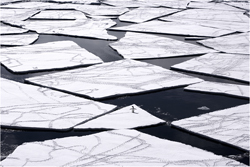 Adélie Penguin on Pack Ice
Adélie Penguin on Pack Ice
The ship sat motionless in a slow tide of broken ice, creeping toward the shores of Franklin Island in the Ross Sea, Antarctica. Hunting parties from the island’s western colony of 100,000 Adélie penguins exploded from the water like so many corks, crash landing on the newly arrived puzzle of floating ice, leaving parts of their stories written in the snow.
As the flotilla eased closer to the island, eventually only one of the platforms remained disconnected from the entanglement of footprints, the proof of life. Engines rumbled and the ship fought inertia to back away from the island. At the same time, a lone Adélie popped out of the icy water onto a platform abutting the last untracked piece. The penguin tobogganed on its stomach to the closest edge, stood up and jumped the small gap between the floating platforms. Tracks now connected every piece of the flotilla into the penguins’ story. And as the bow of the ship slid backwards past the scene, the penguin turned its attention, for the first time, to the tower of steel burping thick black smoke into the clear blue sky. Deeming the ship to be no threat, the bird returned to its business, walking a few more feet before diving back into the sea.
Those etched pieces of ice surely floated out to sea and melted sometime in 2006, but the penguins remain on their paths, tracking across new flotillas of ice every year as their world transforms faster and faster around them. But climate change is now compounded by other threats to their survival...
 Wave in the Southern Ocean
Wave in the Southern Ocean
The great Southern Ocean spins legend around Antarctica, stretching outward to the edge of imagination. In a pocket between towering ten-meter swells, the ship is rolled 35 degrees left. It rolls back on the way up the face of the swell, reaching dead-center at the top, and as the swell drops away continues to roll another sickening 35 degrees right, cork-screwing down into the next pocket until the bow slams another swell, sending an angry curtain of salt-white spray 20 meters into the air.
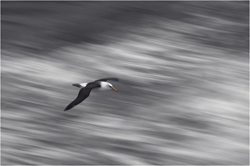 Black-Browed Albatross
Black-Browed Albatross
Above a cresting swell, an apparition with a 2-meter wingspan, a black-browed Albatross slices the fierce gusts with nonchalant precision, one pterodactyl wingtip nearly dragging a lazy arc in the monstrous wave.
The bird expertly glides, weaves, tacks, wheels and pivots, but rarely flaps. The albatross will spend months at sea, relying entirely on the famous Southern Ocean winds for safe passage back to one of the lonely sub-Antarctic islands where it nests. Of the 22 species of albatross, 17 are classified by the IUCN as vulnerable or endangered, the unintentional victims ofSouthern Ocean long line fisheries, which hook and drown an estimated 40,000 birds a year in the quest for tuna and the now equally depleted Patagonian toothfish.
The albatross sweeps, crosses, and coasts up and over the vast silver-black mountains of water until, as the ship slides uneasily into another pocket, the ocean flexes again and the bird is gone.
 Midnight Sun Over Pack Ice
Midnight Sun Over Pack Ice
Far south of the raging ocean the air and water are almost still, and the great birds of the Southern Ocean are left behind to ride the wind. The night, too, is left behind, and the midnight sun glows orange as it pauses briefly on the horizon, illuminating a thin white band at the splitting of sea and sky – the edge of the ice. But past the edge, the jigsaw puzzle of pack ice extends to the horizon in all directions.
Antarctica is extreme. It is more than one and a half times the size of the United States. During the three months of Antarctic summer, the sun never sets. Conversely in winter, the sun never rises, air temperatures drop to -40°C, and the ocean freezes into a 3-meter thick slab of ice, effectively doubling the size of the continent.
In summer, that slab of ice breaks up into the pack and eventually melts, only to be replaced the next winter.
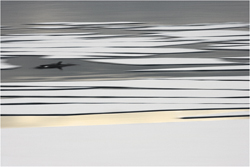 Killer Whale in the Pack Ice
Killer Whale in the Pack Ice
Pods of killer whales, sometimes 100 strong, patrol the ice edges. The males are easy to pick out. Two-meter-tall dorsal fins cut through the water, black knives against the ice.
The State of the Oceans and The Ross Sea
The Ross Sea is special. The National Science Foundation stated back in 1998, “Little, if any of the ocean remains unaffected by fisheries, agricultural runoff, sewage, aquaculture and industry.” The oceans are in serious trouble. The situation is getting worse.
For one, we are catching fewer fish. Estimates are that we’ve eaten our way through 90% of the top predatory fish in the ocean since 1950. We have pushed many ocean ecosystems to the brink of collapse worldwide. The evidence, if we dare to look at it, is clear.
But the Ross Sea, protected by its 500-mile-wide shield of ice, has remained largely insulated from this depletion. Many scientists have stated they believe that the Ross Sea may be the most healthy open ocean ecosystem left on earth.
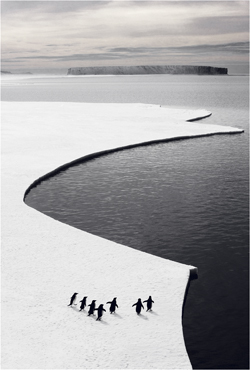 Adélie Penguins on the Fast Ice Edge
Adélie Penguins on the Fast Ice Edge
Every form of life in the Ross Sea must be understood and appreciated in the context of the extreme seascape.
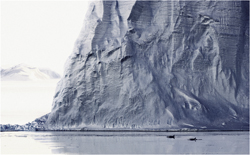 Killer Whales and Icebergs
Killer Whales and Icebergs
At the Ross Sea’s southern boundary, water meets a wall of ice cliffs 40 meters high and 700 kilometers long, known in maritime lore as the “Ross Barrier”. But the barrier is floating. Deep under the wall, the sea continues southward toward the continent. The Ross Ice Shelf is actually the edge of the continental ice cap, which flows off the continent in a massive ice river, and floats out over the southern Ross Sea, 400 meters thick. This floating shelf is the size of France. Like all the icebergs that calve off the imposing front, 90% of it is underwater. The cliffs only hint at the unimaginable ice-mass below.
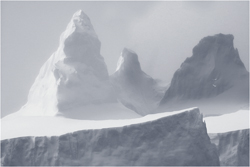 Snow Petrels
Snow Petrels
Over the rich waters at the northern edge of the Ross Sea, pure white snow petrels glow against overcast skies. They bank hard left and right on delicately pointed origami wings, like flecks of paper suspended in swirling winds. They look impossibly small and fragile against the ice and clouds, but in fact they are the southern-most breeding animals in the world. They make their nests in exposed rock cliffs, a hundred kilometers into the Antarctic continent itself. Many sites are as yet unseen by human eyes.
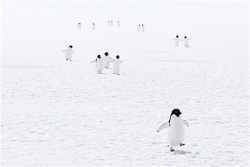 Adélie Penguins Walking Back From a Hunt
Adélie Penguins Walking Back From a Hunt
Bellies full of fish, hunting parties start a long walk back to the Cape Royds colony. Adélies breed on Antarctica’s few patches of bare ground – pinprick islands and rock outcrops. They return, for the most part, to the same colonies where they were born, making their nests from the very same pebbles that their ancestors have used for thousands of years. The ancient ceremonies of moving, stealing, and rearranging the sharp volcanic pebbles have worn them smooth.
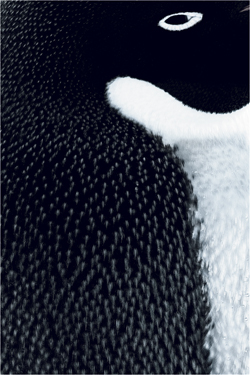 Adélie Penguin Detail
Adélie Penguin Detail
The penguins had no fear as they approached. They waddled up to within a few feet, surrounding me, and settled down in a comic shuffling of positions as they yawned, preened, and stretched. Eventually they started to puff out newly manicured feathers against the cold and slowly fell asleep standing around me on the ice.
Trophic Cascades
An ecosystem is a collection of tightly interconnected organisms that live in dynamic balance. Each member depends on the other members to create that balance. Some species have familiar connections, like that between direct competitors or between predators and prey. Others
have indirect, but no less important, connections like that between a species and the predator of its predator, or that between a species and the predator of its competitor. It is a grand play of checks and balances. In essence, the ecosystem acts as a single organism.
Any sort of damage to one part of this organism trickles through the maze of interconnections, affecting every other part of the system in some way, or multiple ways. The balance changes entirely.
Effects from these trophic cascades are complex and often unexpected. Take, for one example, a connection between Antarctic toothfish and Adélie penguins, right now the focus of research. The toothfish is the largest predatory fish in the Ross Sea, and the Adélie is the most prolific penguin. Toothfish rarely eat Adélies, and we don’t know yet if Adélies feed on young toothfish. But we do know they share the same prey – Antarctic silverfish. As the Ross Sea toothfish fishery depletes the overall toothfish population, more silverfish will become available. With less competition to feed on silverfish, Adélie populations in the southern Ross Sea would be expected to rise, and they are. While this might seem like a good thing, an explosion of Adélies could have devastating consequences on the Ross Sea ecosystem. As Adélies gorge on silverfish and krill, they may begin outcompeting other fish, seals, and whales – in turn reducing their populations. We really don’t know what would happen if we upset the balance in this coevolving ecosystem. But we do know that devastating scenarios have played out before in many parts of the world’s oceans when other top predators, like sharks, have been depleted.
This chain of events also weakens the system’s defenses against invasive species and makes it more susceptible to the forces of climate change. The effects of this weakened “immune system” also have been shown again and again in systems where top predators have been removed.
Scientists are seeing the first signs that the toothfish fishery is already changing the Ross Sea. But it is not yet too late to stop. The Ross Sea can still rebound if we act now.
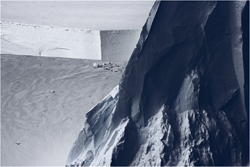 South Polar Skua and Tabular Icebergs
South Polar Skua and Tabular Icebergs
Floating mountains of blue ice saw at the sky like jagged teeth, their 200-foot-tall spires and cleaved cliffs brought into perspective only in comparison to the south polar skuas, their one and a half meter wingspans almost invisible against the looming bergs.
 Snow Petrel, Iceberg and Volcanic Cliffs
Snow Petrel, Iceberg and Volcanic Cliffs
The Ross Sea landscape is a synthesis of fire and ice. A series of volcanoes extends from the southwestern corner of the Ross Sea in a north-south line. Extinct domes rise high above the water to form the black rock cliffs of Beaufort and Franklin Islands, while Mount Erebus, 3,800 meters high, presides over Ross Island. It is the southern-most active volcano in the world. At the center of the crater is an exposed lava lake, one of only a few of its kind. At times, it is reported to erupt as frequently as twice a day.
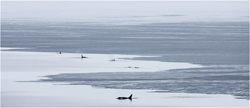 Pod of Killer Whales in Cape Royds Polynya
Pod of Killer Whales in Cape Royds Polynya
A polyna is an oasis – an area of open water surrounded by unbroken sea ice. The open water allows phytoplankton to bloom, bringing krill and silverfish. Polynyas are lifeblood for penguins, and many polynyas support large colonies.
In January 2009, the seasonal polynya off of Cape Royds finally opened. Over the course of twelve days the frozen sea gave way to a mirrored lake, two miles long and half a mile wide. The ice didn’t pile up anywhere, pushed out of the way by the wind. It just disappeared, melted away.
A minke whale found the polynya three days after it opened. The orcas followed two days later. On that dead-still night the sounds of whales breathing carried across the water, clearly heard from anywhere in the polynya. Very thin crisscrossing cracks in the 20 miles of ice between the polynya and open water had left a hopscotch of tiny breathing holes for the whales to traverse the expanse.
But how had the whales found this isolated pocket of water? It seems a risk to take a twenty mile trip under the ice without a destination in mind, and some scientists believe that individual whales have specialized local knowledge. Whales play important roles in these isolated oases. And if individual whales are armed with unique knowledge about the existence of these isolated pockets of water, it would mean that the whales are valuable as individuals in polynya ecosystems. One whale would not be replaceable with another. The minke and orcas that arrived in the Cape Royds polynya in January 2009 may have already known it was likely to be there.
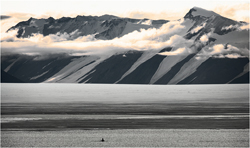 Killer Whale and The Royal Society Range
Killer Whale and The Royal Society Range
The Ross Sea is the primary range for a distinct population of killer whales, dubbed ecotype C. These orcas are much smaller than their global counterparts, have different markings and tend to gather in large groups. Many researchers consider them a distinct species. Other orcas in the Ross Sea feed on seals, penguins, or other whales, but ecotype C feeds almost exclusively on toothfish. Scientists in the Ross Sea have observed a dramatic decrease in these fish-eating killer whales concurrent with the rise of the Ross Sea toothfish fishery.
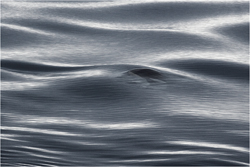 Killer Whale Breaking the Surface
Killer Whale Breaking the Surface
A killer whale rises from a dive, the water bending and stretching around its head in the instant before it breaks through. In that split second, the whale is nothing more than a ghostly shape beneath the water – an errant wave – and the ocean has eyes.
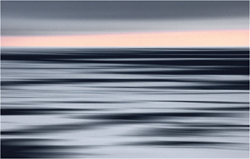 Dawn Colors Over The Pack Ice
Dawn Colors Over The Pack Ice
The waking of dawn means something different in Antarctica. After up to six months of night, a low glow slowly grows at the horizon. In its purest form at the pole, sunrise itself lasts for 30 hours. The sun will set six months later. But the glowing light, lasts months, reflecting off the clouds with subtlety and intensity of color in equal measure. The clouds move in relation to the midnight sun, repainting the ice and sky moment to moment.
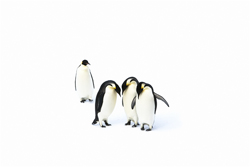 Emperor Penguins
Emperor Penguins
Around the borders of the Ross Sea, sections of sea ice remain locked in place almost all year by capes and grounded icebergs. On this fast ice, facing pairs of emperor penguins croon their ancient song. Unlike Adélies, the Emperors breed on the sea-ice itself, laying a single egg in the dead of winter. They have no nest, and the males stand upright for the months of Antarctic night, holding the eggs on their feet, protecting the precious packages from the deadly cold.
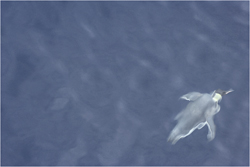 Emperor Penguin Surfacing After a Dive
Emperor Penguin Surfacing After a Dive
Emperors are the best avian divers in the world, reaching depths of 600 meters, and dive times of up to 20 minutes. Just before a dive, the bird races its heart to 250 beats per minute, saturating its body with oxygen. As soon as it hits the water, the bird drops its heart rate back to 60 beats per minute, and on the longest of these dives, an emperor can slow its heart rate to a mere 6 beats a minute. One scientist researching these penguins is also a doctor. He is studying the bird’s physiology to develop new treatments for his heart patients: Emperors mimic a human heart attack on each dive with no ill effects.
 Blue Iceberg on the Horizon
Blue Iceberg on the Horizon
Icebergs start off as light snow falling on the Antarctic continent. The snow compresses, becoming more and more compacted over thousands, if not millions of years, eventually forming glacial ice. The glacial ice is viscous plastic, moving under its own immense weight from the center of the ice cap out to the coast, where the ice rivers are pushed off the continent and out to sea. The floating fronts of ice tongues and ice shelves can be hundreds of miles long. The fronts calve into the ocean, releasing large white tabular icebergs.
The wind, sun, waves and currents then unleash their forces on the bergs, sculpting in infinite variety.
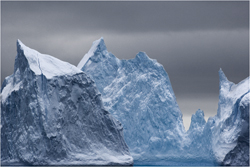 Icebergs
Icebergs
Some icebergs stretch hundreds of kilometers, altering ocean currents and weather, and can be tracked by satellites. Over the course of many years they melt back into the ocean.
But snow and ice continue to build up on the continent, offsetting the loss. Antarctica holds 90% of the world’s ice. A change in the cycle of ice would have global consequence. A recent study by the British Antarctic Survey found that glaciers in the Western part of Antarctica are discharging ice into the ocean at an accelerating rate. Over the next century, worldwide sea levels could rise by 1.5 meters if this rate continues. Our great grandchildren will know a very different world.
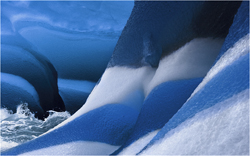 Ancient Ice
Ancient Ice
Older icebergs are deep hues of green and blue, their color divulging their age. The older a layer of ice gets, the denser it becomes, the more wavelengths of light it absorbs. The oldest layers are so dense that they glow as pure blue, green or black ice.
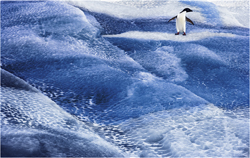 Adélie Penguin on Striped Iceberg
Adélie Penguin on Striped Iceberg
An Adélie surveys the scene from a high perch on the exposed underbelly of an old berg, the cupped divots of the icy surface betraying that the berg eroded unevenly, became unbalanced and rolled over.
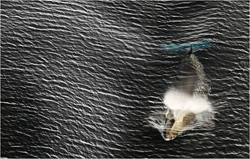 Minke Whale
Minke Whale
Deep into the pack ice, the floating puzzle-pieces are huge – 600 square kilometers – and act like tectonic plates. They collide to form jumbled piles of ice at the margins, and when they spread apart, the seascape looks strangely like aerial views of lakes and connecting rivers; but of course this is an illusion. These lakes and rivers continually open and close as the pack ice shifts. Still, the open water teams with phytoplankton, tiny shrimp-like krill and Antarctic silverfish. Minke whales and killer whales follow the seams between the plates, finding these most inaccessible pockets of water to eat the bounty.
A misty cloud drifts across the ice when one of the animals breaks the surface, exhaling a salty spray and then filling its huge lungs with a
nother breath.
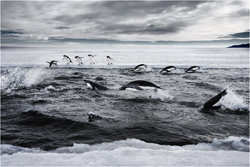 Adélie Penguins Hunting
Adélie Penguins Hunting
The fallout from a 2°C rise in average global temperature from pre-industrial levels will have profound impact on both Adélie and Emperor penguins. As the extent and thickness of sea ice, the temperature, and the wind regimes change, so must the penguins adapt. Emperors will have the worst of it, and many colonies, including the cast of March of the Penguins, are expected to die out– unable to find suitable breeding sites as the fast ice disappears. Adélies are expected to struggle with loss of winter habitat, increased competition from more temperate penguin species, and higher probability of summer snowstorms, which can kill a whole generation of a colony’s chicks if it comes at the wrong time.
The Ross Sea is already experiencing the complex effects of climate change. Despite the overall warming of Antarctica and due to changing westerly wind regimes, sea ice was actually more persistent than usual in McMurdo Sound in 2008-2009. The persistent ice made Adélies at the Cape Royds colony walk much further to get back and forth from the edge of the ice to hunt as their mates waited on the nest. The walk was so long, in fact, that many of the waiting penguins, facing starvation, had to abandon their nests and go in search of food themselves. Eighty-five percent of the Cape Royds nests failed that year. Finally, but too late to save most of the nests, a 2-mile-long, 20-foot-wide crack opened in the fast ice only 4 miles from the colony. With this new access to food, the penguins gorged themselves on krill. The power and focus of the birds as they hunted in the crack was a true spectacle.
 Adélie Penguins Underwater
Adélie Penguins Underwater
Throngs of Adélie penguins rocket past the edges of the ice just under the surface, trailing long bridal-veils of white bubbles in the cerulean blue.
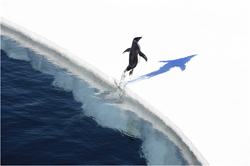 Adélie Penguin Breaching onto the Ice
Adélie Penguin Breaching onto the Ice
An Adélie penguin launches itself out of the water and onto the ice, accelerating before the edge to decrease the possibility of providing a meal for potentially lurking leopard seals.
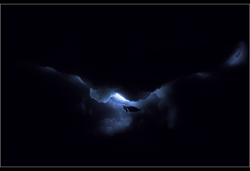 Weddell Seal Rising to a Hole in the Ice
Weddell Seal Rising to a Hole in the Ice
Water temperature in the Ross Sea hovers around -1.8°C, the freezing point of salt water. But the frigid water is filled with life. So to really understand the Ross Sea, you have to don a dry suit and tank.
Deep in McMurdo Sound, a small black volcanic island juts out of the fast ice, dwarfed by Mount Erebus. Around the island the fast-ice buckles, forming a complex of ridges and cracks as currents slowly shove the entire mass of floating fast-ice into the rocky shore.
Dropping through a tunnel of ice near Turtle Rock, shades of blue and cyan replace the veils of white, and the ice above becomes the low-hanging blanket of expectant clouds in a slow-moving front. It connects with the black water at the margin in a seamless hinge. There is no current, and visibility is nearly half a mile – 10 times that of the clearest water anywhere else in the world.
And then there are the sirens… Above water Weddell seals are barely mobile as they lie on the ice, but below water they dance and sing.
Their voices are more than sound. The call seems to start as semi-conscious thought, a memory of wind whistling through a drafty window, sharp and sweet. It has no direction, no source, and it cuts cleanly through the dark shadows of the mind even before the tone starts to accelerate and deepen, crossing fully into consciousness as the long descending note breaks abruptly into thumping vibration, almost too deep to hear.
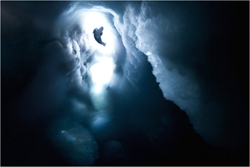 Weddell Pup
Weddell Pup
Weddell seals are the southern-most mammals in the world. Adélie penguins, whales and petrels all migrate north in the winter, but the Weddells stay.
The ridges and pressure cracks around the seal colonies provide precious portals to the water beneath the ice. The seals maintain the portals all winter long, raking their teeth along the edges to keep them from freezing shut.
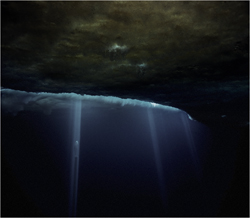 Shafts of Light and Weddell Seal
Shafts of Light and Weddell Seal
The seasonal fast-ice surrounding Turtle Rock was approximately 2.5 meters thick in 2008, and though it was more than sufficient for vehicles and a dive hut, it was still in motion. Fifty meters past the dive-hut was the evidence: a gapping crack, arched underneath like a railroad tunnel, perhaps 3 meters across and extending into the distance as far as the eye could see. The crack is a function of the geography in that part of the Sound and the prevailing ice movement; thus it forms every year in nearly the same spot. It has done so for millennia, providing predictable access for the seals, which slip smoothly into the water through holes in the thin ice at the center of the arch. At the right time of day, shafts of light shoot down through the seal-holes, illuminating patches of the seafloor, nearly 70 meters below.
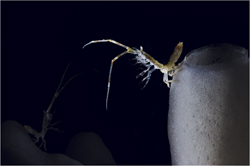 Antarcturus on Glass Sponge
Antarcturus on Glass Sponge
Beneath the seal colony, the ocean floor is a mosaic. Writhing piles of lurid sea stars, urchins and meter-long nemertean worms eat anything a seal drops. Attached to the rocks, anemones wave their many arms in search of food. Giant sea spiders walk the substrate with their bizarre walk, sometimes taking amphipods or other freeloading passengers along for the ride on their vivid red legs.
Isopods like Antarcturus often stand on top of small sponges to feed on passing zooplankton. They brood their eggs for a year, which hatch during the yearly phytoplankton bloom. Deeper still, giant sponges filter the water, some larger than 50-gallon drums and thought to be centuries old.
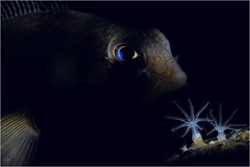 Trematomus bernacchii
Trematomus bernacchii
Trematomus bernacchii, like other fishes in this icy water, is equipped with natural antifreeze, but it will die of heatstroke at only 6°C, the lowest heat threshold of any animal. Trematomus is directly related to 30 other species of fish in the Ross Sea, all of which hail from a single ancestor. Together they form one of the only known examples of a ‘species flock,’ where a single branch of the evolutionary tree radiated into a community of animals that fill every niche. Even the Antarctic toothfish is part of this flock.
 Monocaulus parvula
Monocaulus parvula
Even in a place with 24-hour daylight, the sun dips towards the horizon at midnight, sending long beams of angled light across the ice. The low light triggers the reef to switch shifts. Monocaulus parvula is part of the second shift, solitary flowers opened to the night. The hydroid will release free-swimming young from the pale orange gonophores in the center of its corolla of tentacles, but this night it is only interested in a meal.
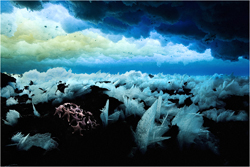 Seastars and Anchor Ice
Seastars and Anchor Ice
The continent itself is so cold that it sucks heat away from the rocks on the seafloor. The seawater freezes to the subzero rocks, forming fields of stalagmites, the anchor ice. Anchor ice will even form around the benthic creatures, sometimes killing an urchin or anemone by breaking off and floating up to the underside of the sea ice with the helpless animal still attached.
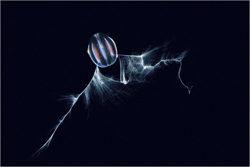 Mertensiid Ctenophore
Mertensiid Ctenophore
Luminous ctenophores float in mid-water, covered in lines of cilia, like finely toothed combs. The teeth of the combs flex in coordinated waves, allowing the animal to move slowly forward. Bursts of deeply saturated color follow each wave as it passes through the lines of cilia. The water is filled with fireflies. One species unfurls a net of fine filaments behind it, like a drop of milk spreading out in a cup of water. It is hunting for those that go almost unseen without a microscope. It is late in the season, and a forest of floating microbes like Phaeocystis antarctica, is on the way.
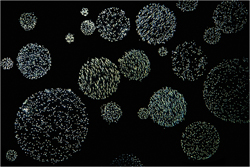 Phaeocystis antarctica
Phaeocystis antarctica
In the winter, unobstructed by obstacles, 200 kph winds shoot off the Ross Ice Shelf and out across the Ross Sea. These winds push the blanket of seasonal ice away from the edge of the shelf, creating a large pool of open water – a polynya – even when the rest of the sea is covered in ice. When the sun finally rises after the long night, phytoplankton bloom prolifically with the light and open water. The bloom is so large and so dense that it can be seen from space. Later in the season, a clockwise current pulls the bloom under the fast ice and into McMurdo Sound. The crystal clear water turns to a greenish soup in days. This is the big feed.
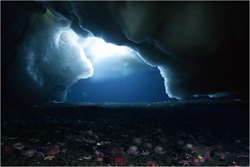 Ice Cave
Ice Cave
The entrance of the cave was hidden around a thick wall of ice, extending from the shelf floor to the ceiling 10 meters above. The darkness was immense, seemingly impenetrable, until I had turned the corner around the great triangular wedge. There, a 3-meter archway led to a cathedral chamber, filled with light. I swam carefully under arch and into the chamber, floating only half a meter off the seafloor.
The ceiling of the chamber was like a cloud formation from an El Greco painting – tortured clouds and shafts of light. The end of the chamber narrowed, seemingly ending in another wall of ice, touching the ocean floor. But behind that wall was another archway, this one only a meter high. It was nearly pitch black again, the brilliant light of the first chamber now hidden behind the wall, but I could see a dull blue light beyond the arch. I was 16 minutes into the dive, so I floated through into the second chamber. My eyes adjusted to the dim light. An assortment of benthic creatures had assembled on a small group of rocks. It looked like they had been arranged by hand. A thin blue crack in the low ceiling seemed to originate from the assemblage, snaking up like a plume of smoke. It was perfect.
I carefully placed the legs of my tripod on the seabed and hung on, rotating to release air from my suit and reset my buoyancy before I let go. I rotated back, now neutrally buoyant again without the weight of the camera and tripod, floating just above the seabed. I started to work. I positioned the camera, and pointing my dive-light at the sea stars, brought the scene into focus. The tiny knobs on the strobes required extra attention in the dark and cold and I was so concentrated on the work that I was oblivious to other movement nearby…
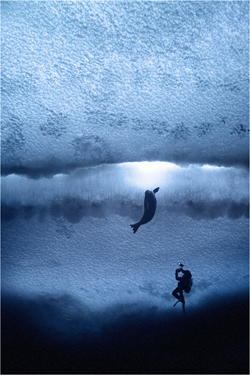 Rob Robbins and Weddell Seal
Rob Robbins and Weddell Seal
…The blast was so loud that at first I didn’t even recognize it as a noise. It seemed as though a jet engine had started up in my head, a shockwave of buzzing bees exploding through every inch of my body. I couldn’t see! My eyes instantly defocused, registering, as I remember, only a dull line of blue light from the crack, and darkness encroached from all sides. I’ve used a jackhammer a few times to break up concrete in my back yard, and this is the only experience that remotely relates to the rest of the sensation. My entire body felt like my arms and shoulders do after an hour on the jackhammer – numb, unresponsive, almost as if they aren’t mine to control. I had no idea if I was breathing or not.
The final thumping notes pumped through me, and then ended, but the bees remained, buzzing under every inch of flesh. My eyes regained some focus, but everything was still fuzzy. I fought hard against it, trying to regain control. And now I finally had time to be terrified. I was gulping air, but felt completely out of breath. I realized I was lying on my side on the seabed. I had tipped to my right, losing air from my suit through the shoulder vent, but I didn’t understand this part of it right away. Some of the haze was actually the silt that I was now stirring up, and I flailed in it, trying vaguely to get away, worsening the situation. Through the silt, I could see the massive Weddell seal hovering directly above me. Thought finally kicked in, and my hand shot to my chest, filling my suit with air, lifting me off the seafloor. I grabbed the tripod, and tried to move, again forgetting to add more air to the suit, dragging the camera for a meter before I remembered. Somehow in the midst of panic, I registered that a few of the sea stars had been dislodged from the rocks in the untaken photograph.
I swam backward away from the seal, which had turned slightly to watch me, and then I flipped over and kicked hard in the direction of the arch, forcefully folding the legs of the tripod as I swam. I made it through the arch and into the first chamber with no problem. I had regained control of my breathing as I was exiting the cave complex, but my heart was still pounding in my chest, and every muscle was exhausted. I looked back once at the corner of the great wall of ice before I started to ascend. I saw only darkness.
During the next week I related this story to my colleagues, one of whom confirmed that very intense Weddell sounds had been recorded, in some cases as loud as small dynamite explosions. But no one had yet explained why the seals produced such loud noises.
When I told the story to Dr. David Ainley, he immediately made a connection between my experience and other unexplained Weddell seal behaviors. Weddells have been repeatedly observed bringing huge, 100-kilogram Antarctic toothfish up into holes in the ice. These fish, some half the size of the seal, reveal no tooth marks and are placid rather than being dead. How could the seals so easily manage these huge fish? We surmised that the seals must use sonic blasts, like the seal did to me, in order to subdue the massive fish!
 Snow Petrel and Tabular Iceberg
Snow Petrel and Tabular Iceberg
Our understanding of the Ross Sea ecosystem – of any marine ecosystem, for that matter – is only in its infancy. Scientists are just starting to unravel the web of entanglement, the DNA of the ecosystem itself. And in a place where life is molded by the ice, already balanced on the boundary of the possible, it is critical that we truly know the consequences of our actions before we act. And we must admit when we don’t know enough.
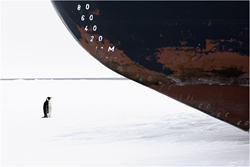 Emperor Penguin and Ice Breaker
Emperor Penguin and Ice Breaker
The 19th-century whaling station of Grytviken on South Georgia Island stands like an open grave for the great whales of the Southern Ocean, 90% of which fell to lubricate the industrial revolution. After a quarter century of protection, blue whales have yet to return to the northern Ross Sea. But aside from that loss, the Ross Sea is perhaps the least damaged marine ecosystem on earth. There have been no reported red tides, no mysterious fish or bird die-offs, no introductions of non-native species, no invasions of jellyfish. There has been no oil drilling, widespread chemical pollution, or spread of plastics. The ecosystem is intact, functioning almost as it did before we spread our nets and caught the majority of top predators in the world’s ocean. The Ross Sea is one of the last crown jewels.
But driven by depletion to find the last healthy fish stocks around the world, industry has come again to the Ross Sea, this time with fifty-kilometer-long lines of hooks intended for the Antarctic toothfish.
Over the last century, fishermen have been forced into deeper, more remote waters to keep up with global demands. The Ross Sea is the end of the line; the Antarctic toothfish now supports the most remote fishery on Earth. The industry is already sending observable shockwaves of extraction through the web of interconnections in the Ross Sea.
The Antarctic Treaty, Fishing, and Policy in the Ross Sea
In 1959 nations from across the globe signed the Antarctic Treaty, a monumental agreement that set aside the entire Antarctic continent as a preserve for science and peace.
Yet the Southern Ocean, surrounding Antarctica, was left out of the agreement. The least protected waters in the world surround the most protected land. While no country can lay claim to the land or sea of Antarctica, nations can apply to fish there and others simply sneak in illegally.
In 1996, the first commercial long line vessel penetrated the Ross Sea pack ice in search of Antarctic toothfish, better known by its market name “Chilean sea bass.” Why are we fishing all the way in Antarctica? The answer is simple: our fisheries close to home can no longer meet the demands of a growing world population, hungry for fish.
We know very little about the Antarctic toothfish. It is caught deeper than 2,000 meters and, as with most deep dwelling fish, Antarctic toothfish are long-lived (up to 40 years), slow growing, and late to mature – all traits that make them incredibly vulnerable to overfishing. The Patagonian toothfish, a northern cousin also sold as Chilean sea bass, is a cautionary tale. This fish shares all the same traits, and many regional stocks were severely overfished in only 10-15 years.
For the most part, the Antarctic toothfish remains shrouded in mystery. No one yet knows for sure when and where they spawn. To date, no one has found a larval toothfish. And we are only beginning to unravel this fish’s role in the ecosystem. As the largest fish predator in the Southern Ocean – growing in excess of two meters and 90 kilograms, (three to four times as large as most Antarctic fish), they surely play an important role. Without even basic life-history information, accurate management for this international fishery, which supports up to 20 boats removing 3,000 tons a year, is impossible. Despite the lack of necessary data, the fishery recently received a green label certification through the Marine Stewardship Council, much to the outrage of environmental organizations and scientists around the world.
A recent global analysis reiterated that the Ross Sea is likely the most intact marine ecosystem left on the planet. Due to the Ross Sea’s remarkable value to science, and in line with the original goals of the Antarctic Treaty, more than 500 scientists have pooled their voices, pleading to CCAMLR (the Convention on the Conservation of Antarctic Marine Living Resources), which overseas management of marine life in the Southern Ocean, to stop the Ross Sea Antarctic toothfish fishery. These scientists have now joined forces with international non-profits, media specialists and policy makers in promoting a marine protected area encompassing the entire Ross Sea. A movement is underway.
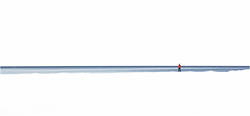 Man on the Ice
Man on the Ice
The Ross Sea story is not just that of a fish, or of the incredible creatures that live at the edge of the world. It is our story, the story of our struggle to become sustainable. We need to know the story in this way. We need to admit what is known: we have dangerously overexploited the oceans. We need to stop and protect the places we have justify. We need to start with the Ross Sea.
And what if we did? Imagine the 48 nations of the Antarctic Treaty System speaking as one to proclaim the importance of marine conservation in its purest form – a marine protected area, a gift to our future. Imagine that voice amplified across the Antarctic by an entire network of protected areas designed to insulate these vulnerable animals from direct depletion as they fight for their lives in a melting world. Imagine how far such a clear, humane, self-preserving act could take us.
The Ross Sea is the Last Ocean. We have very little time to act. Our fates are all linked, and in facing a changing climate and exponentially increasing pressure on world resources, we all must work as a single community. This is the only path to peace.